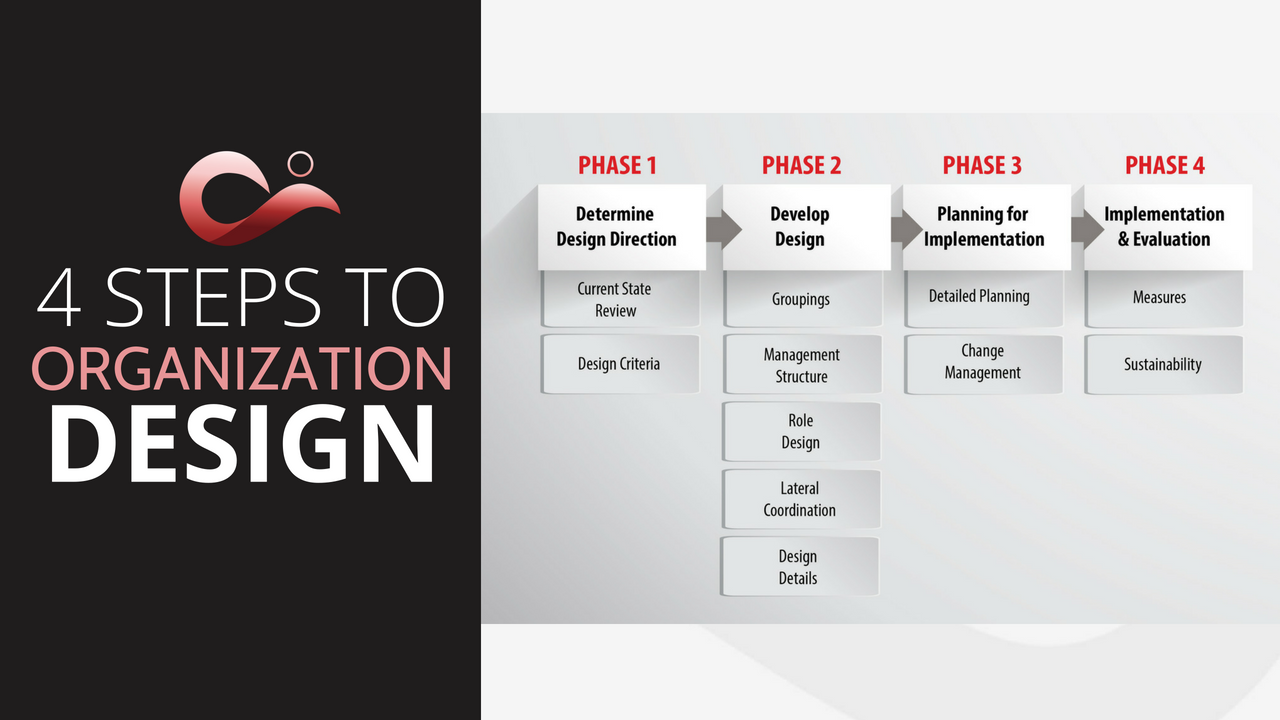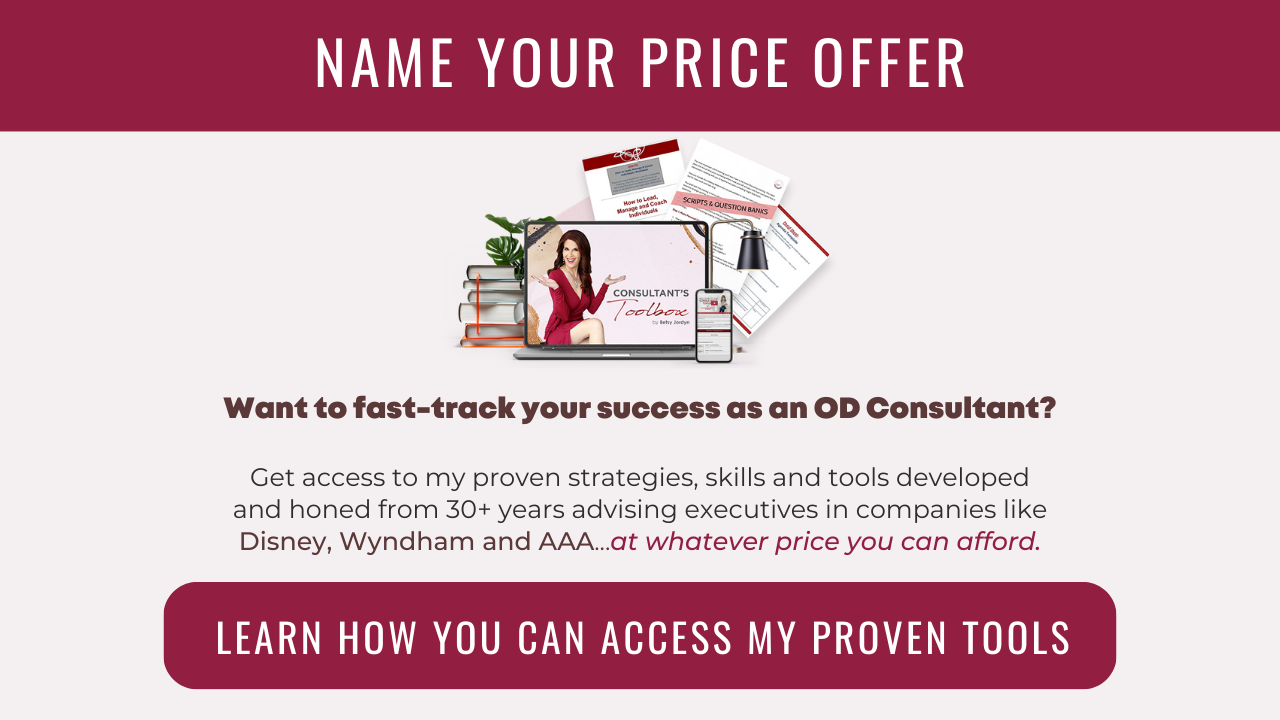What Steps Are Involved In An Organization (Re) Design
Jan 13, 2017
Wondering what are the steps involved in an organization redesign? Let me demystify this complex, high-value consulting solution.
There are four phases of a redesign: determining design direction, developing the design, planning the implementation, and implementing and evaluating.
As you guide your clients through each phase, they need to address both hardware-related issues (e.g., processes, reporting relationships, spans of control, etc.) and software-related issues(e.g., leader and employee behavior and performance patterns). You, as a consultant, add value by helping them address both simultaneously.
The following are suggestions of what you can offer your clients within each phase and how to increase your consultation fee while adding value.
Phase 1: Determine Organizational Design Direction
Position yourself to support the client's goal at this phase of organizational development and redesign. Craft a compelling rationale for change and an inspirational vision of the future.
Hardware considerations:
- Help the client develop the business case for a redesign. Offer to facilitate a meeting to clearly define what they want to accomplish with the redesign effort.
- Propose that you complete a current state review. In your current state review, you can find out: What's working/not working today? What reasons do we have to re-organize? Are they good ones? What are our customer requirements/business strategy needs? How will redesign affect our process/workflow requirements?
- Facilitate the senior team in coming up with a list of Design Criteria, which is a list containing the various positive results that the organization redesign is expected to provide, such as "responsiveness," "efficiency," or "developing new markets." The design criteria will guide the organizational design process, evaluate options against the process, and eventually measure the entire effort's success.
Software considerations:
People are more likely to buy into a change they had a voice in creating, so involve stakeholders, subject matter experts, and employees as much as possible. Offer an add-on option in your consulting proposal for a "stakeholder assessment, " where you isolate the senior team's feedback and input.
Phase 2: Develop The Organizational Design
Position yourself to provide process leadership to the team to guide them in coming up with a new organizational design.
Hardware considerations:
There are four levels of design:
- Overall Groupings reflect the top layer of the organization. This is the part of organization design that connects to the business strategy and forces the organization to deliver its most important capabilities.
- Management Structure relates to management spans of control and centralization/decentralization of decision-making.
- Role Design defines what each person does and determines individual responsibilities.
- Lateral Coordination refers to inter-departmental coordination (horizontal alignment) and accounts for the ways work is connected among departments.
Software considerations:
As in phase 1, the more employee/stakeholder involvement, the better. Involving employees in the organizational redesign will aid in its adoption later. It will more than likely provide unique insight that top executives don't have about how work gets done in the trenches. Include an add-on option in your consulting proposal for running meetings at key design steps to get the senior team's input and affected employees. Remember, consultation fees that add value are more likely to be accepted by clients.
Phase 3: Plan for Organizational Design Implementation
One common reason that redesign efforts fail is that too many leaders assume the job is finished when the new design is announced. The reality is that when the rubber hits the road, the most challenging part of the work is implementation, which has just begun. Offer yourself as a project manager to ensure that their implementation is done with great care and thoughtfulness.
Hardware considerations:
The new organizational chart is just the tip of the iceberg. Decisions around changes to job titles/descriptions, performance measurement, work processes, physical settings, and more still have to be made. Furthermore, make sure your client crafts a comprehensive plan to move the organization from today to its desired future state.
Software considerations:
The implementation plan has to consider the organization's readiness and capacity to absorb and integrate the change. Pacing can't be too slow, which causes a loss of momentum, but it also can't be so fast that the organization cracks from the pressure. You will also need to help the client consider how resistance to change will be anticipated and managed.
Phase 4: Implementation and Evaluation of The Redesign
Your clients (with your help) have analyzed, designed, and pondered. Now, it is time to act! Offer yourself as an on-call expert advisor, ready to help them with in-the-moment implementation issues and challenges.
Hardware considerations:
Help your clients put metrics and hyper-care into place to ensure success. Offer an add-on option in your consulting proposal to help track and monitor progress and make course corrections when needed.
Software considerations:
Performance that aligns with the new direction captured in the new organization design must be fostered and rewarded, especially in key leadership roles. The worst mistake organizations make at this phase is retaining visible leaders and employees who do not adjust to the new normal after a reasonable amount of time. Offer your support for the selection of individuals for crucial, visible positions.
Related Blog, Video, or Podcast Episode:
How to Uncover the Root Cause of Poor Performance
Next Step
The OD Consultant’s Toolbox is all about landing and delivering strategic consulting engagements that will make a difference for both your career and the organizations you want to help.
Ready to take your place as a sought-after, credible organizational consultant?
Click here to learn how to get my proven OD best practices, frameworks, and tools...at whatever price you can afford.
Let's Stay Connected!
Actionable inspiration, expert interviews and behind-the-scenes consulting and coaching secrets and best practices and SO MUCH MORE, delivered to your inbox for a weekly dose of entrepreneurial motivation!
We hate SPAM. We will never sell your information, for any reason.


